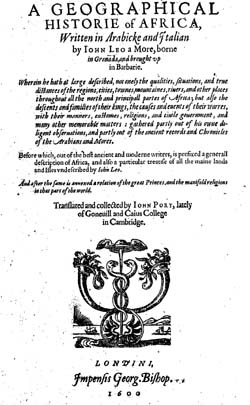Description of Africa (1550 book) facts for kids
Description of Africa was a very important book. It was written by a famous traveler named Leo Africanus. He finished writing it in 1526. The book was first published in 1550 by Giovanni Battista Ramusio. It was part of his collection of travel stories.
This book gave Europeans their first detailed look at North Africa. This included places like modern-day Morocco, Algeria, and Tunisia. It also described the rich gold-trading kingdoms of West Africa. Leo Africanus was a Moorish traveler and merchant. He was captured by pirates and sold as a slave. He was given to Pope Leo X along with his writings. The Pope freed him and he became a Christian. He took the name Leo from the Pope. The Pope asked him to write his book in Italian.
The book became very popular in Europe. It was printed many times. It was also translated into French and Latin in 1556.
What Was Inside the Book?
The Description of Africa had nine parts, or "books."
- One book was an introduction.
- Another book was an appendix about rivers, animals, and plants.
- Seven books described different kingdoms and regions. These included the kingdoms of Marrakesh, Fez, Tlemcen, and Tunis. It also covered Numidia, the sub-Saharan regions, and Egypt.
The book was shared as handwritten copies for many years. A famous scholar named Pietro Bembo read it in 1545. He was amazed by how much detail Leo Africanus knew about Africa.
Why Was This Book Important?
This book was very important because it was so accurate. At the time, Europeans knew very little about Africa. The book came out when European powers were clashing with the Ottoman Empire. It also appeared when Western Africa was becoming more open to Europeans.
The book was a huge success. It was translated into many languages. For decades, and even centuries, it was a main source of information about Africa. The English version came out in 1600. It was translated by John Pory. It was called A Geographical Historie of Africa. Some people think William Shakespeare might have read it. He may have used ideas from it to create the character Othello in his play Othello.
Modern Discoveries About the Book
In the 1900s, the original handwritten version of the book was found. It showed that the first publisher, Ramusio, had changed some parts. He made the text sound more pleasing to Christian European readers. Later French and English translators added even more changes. Newer translations of the book are now more true to what Leo Africanus originally wrote.
|


